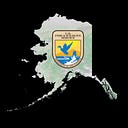Wood Frogs of the Far North
Extreme Resilience in a Changing World

Life at northerly latitudes can be difficult in general, and especially so for terrestrial “cold-blooded” creatures like wood frogs. Long periods of below-freezing temperatures across most of Alaska each winter means that few amphibian species occur here. But wood frogs have a hidden superpower: They can freeze mostly solid without harm.
The wood frog (Lithobates sylvaticus) lives year-round across the upper half of North America, spending much of its time in forests but breeding in ephemeral wetlands as soon as the ice melts. Wood frogs are the only amphibian found commonly across much of Alaska; they even occur north of the Arctic Circle, where winter temperatures regularly plunge below zero.
These frogs engage in a process called “cryo-preservation,” concentrating the sugar alcohol glycerol in their blood to serve as antifreeze. Glycerol helps to slow down and isolate the formation of ice crystals in the frog’s body, preventing lethal damage to organs and tissue. This adaptation allows the frog to spend the coldest months of winter nestled in leaf litter, frozen under several feet of snow. With the arrival of longer days and warming sunlight, the frog thaws out to begin its search for food and mates.
Like most other amphibians, reptiles, fish, and invertebrate animals, wood frogs are ectotherms — they control their body temperature externally, via their surroundings. (Endotherms, by contrast, control their body temperature metabolically, a process that occurs within their bodies.) Ectotherms must absorb heat in order to become warm and active — enough so to eat, mate and escape predation. But the source of ectothermy’s efficiency is also its shortcoming: The sun’s energy doesn’t reach Earth equably, and the planet’s tilt ensures that latitudes far north and south of the Equator receive substantially less of this energy during the winter months.
Being able to freeze solid during the winter allows wood frogs to occupy a vast geographic range, from the Arctic all the way down to the American Southeast. Wood frogs are “the coyotes of the amphibian world,” says Mari Reeves, a U.S. Fish and Wildlife Service biologist who has studied the species extensively in Alaska.
But wood frogs, despite their adaptations, are particularly vulnerable to stressors such as water pollution and climate change. Like all amphibians, wood frogs straddle the realms of water and land, requiring both to complete their life cycle. This, Reeves said, is one reason why amphibians are so important: Because they’re so sensitive to environmental stressors, they act as indicators of ecosystem health.
Even in Alaska’s extremely remote refuges, Reeves and her colleagues have found wood frogs with serious skeletal deformities and eye aberrations. Sometimes these abnormalities can be directly traced to toxic heavy-metal contamination; in other cases, the cause is more complex, involving the interaction of multiple stressors.
The researchers also found Alaskan wood frogs infected with the fungal pathogen Batrachochytrium dendrobatidis, a version of the dreaded chytrid fungus that has recently decimated amphibian populations around the world.
Of the more than 5,700 amphibian species found globally today, more than 30 percent face extinction in the near future. On public lands in the U.S., even species of low conservation concern are suffering steep declines. Yet Reeves contends that amphibians with deformities are in fact an unlikely sign of hope.
“Abnormal frogs show us places where frogs persist, despite the stressors,” she said. The abnormalities should grab our attention because they indicate that, ecologically, something is amiss; it’s up to us to find a path toward remediation.

“Abnormal frogs are troubling, but they’re resilient. What’s more troubling is when we find places where amphibians should occur but they’re not there anymore — the habitat is no longer suitable for them.”
The incredible resilience of creatures like the wood frog should give us hope: If we take action to mitigate our impacts, many species — even very sensitive ones — have the capacity to recover.
In the summer of 2005, several large natural wildfires burned portions of Kenai National Wildlife Refuge, blackening thousands of acres of boreal forest within the 2-million-acre Refuge. Reeves recalled hearing a report from one of the fire crews about a strange noise they noticed one day, emanating from a narrow creek channel too steep to be affected by the flames. It sounded like small ducks quacking. When the fire crew got closer to investigate, they found dozens of wood frogs happily croaking away, seeming to rejoice in their good fortune, spot-on instincts, or both.
Story by Peter Pearsall, Communications Specialist for External Affairs/Migratory Birds in 2021.
In Alaska we are shared stewards of world renowned natural resources and our nation’s last true wild places. Our hope is that each generation has the opportunity to live with, live from, discover and enjoy the wildness of this awe-inspiring land and the people who love and depend on it.
